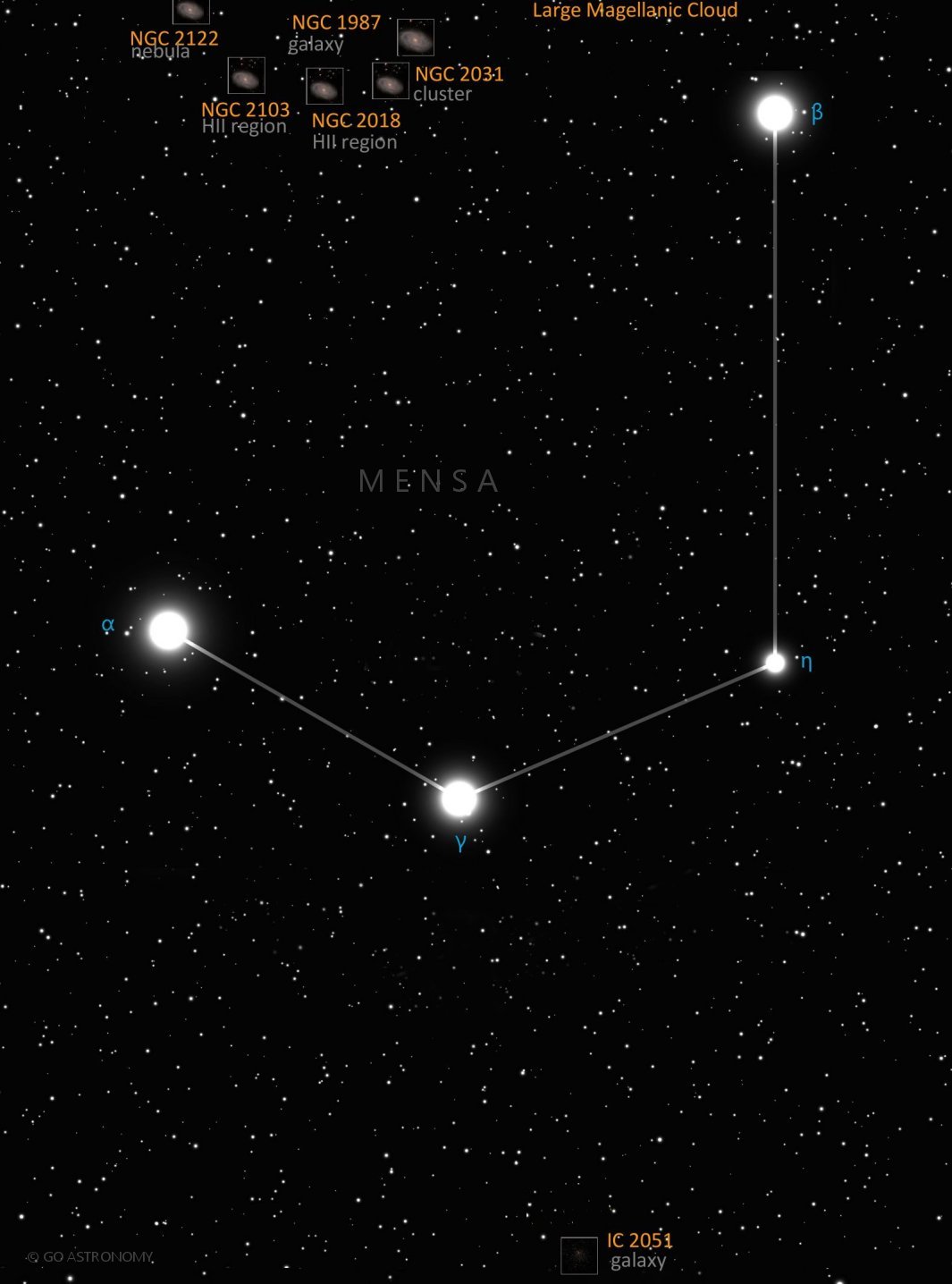Mensa, the Table Mountain (Men)
(MEN-suh)
The Southern constellation of Mensa, the Table Mountain, is best viewed in Winter during the month of January.
Mensa is the 75th largest constellation. It's brightest star is Alpha Mensae at magnitude 5.09. The boundary of the Mensa constellation contains 3 stars that host known exoplanets.
Mensa is a circumpolar constellation, so is visible year-round in the Southern hemisphere. Conversely, it is not visible in the opposite hemisphere.
- Pronunciation:
- MEN-suh
- Meaning:
- Table Mountain
- Genitive:
- Mensae
- Abbreviation:
- Men
- Constellation Family:
- LaCaille
- Hemisphere:
- Southern
- Quadrant:
- SQ1
- Visibility:
- 4° N - 90° S
- Best viewing month*:
- January
- Area:
- 153 sq. degrees
- Size:
- 75th largest
- Circumpolar** (N=northern, S=southern):
- S circumpolar
- Right Ascension (avg):
- 5h 30m
- Declination (avg):
- -77°
- Brightest star:
- Alpha Mensae (5.09)
- Stars with planets:
- 3
- X-ray stars:
- 9 (3 binaries) stars
- Messier objects:
- |
- Caldwell objects:
- |
Brightest Stars in Mensa
The 10 brightest stars in the constellation Mensa by magnitude.
- Star
- Magnitude
- Spectral class
- Alpha Mensae (α Men)
- 5.08
- G5V
- Gamma Mensae (γ Men)
- 5.18
- K4III
- Beta Mensae (β Men)
- 5.3
- G8III
- Theta Mensae (θ Men)
- 5.45
- B9.5V
- Kappa Mensae (κ Men)
- 5.46
- B9.5V
- Eta Mensae (η Men)
- 5.47
- K6III
- Mu Mensae (μ Men)
- 5.53
- B9IV
- Epsilon Mensae (ε Men)
- 5.54
- K2/K3III
- Zeta Mensae (ζ Men)
- 5.61
- A5III
- Pi Mensae (π Men)
- 5.65
- G3IV
Galaxies in Mensa
The most notable galaxies in the constellation Mensa. Also see all galaxies.
The Mountain in the Sky
Mensa, from the Latin for "table," is a small and faint constellation in the southern sky. It represents Table Mountain, a prominent landmark overlooking Cape Town, South Africa. Despite its relatively unassuming appearance, Mensa hosts several astronomical features worthy of exploration.
Historical Overview
Mensa is a relatively modern constellation. It was introduced by the French astronomer Nicolas Louis de Lacaille in the mid-18th century. During a stay at Cape of Good Hope, South Africa, Lacaille devoted himself to observing the southern sky with a 0.5-inch refractor. He introduced 14 constellations in the southern hemisphere, Mensa being one of them. It is the only constellation named after a geographical feature on Earth.
Location and Main Features
Mensa is located in the first quadrant of the southern hemisphere (SQ1) and can be seen at latitudes between +4? and -90?. It is bordered by constellations Dorado, Hydrus, Octans, Chamaeleon, and Volans. Despite being the 75th largest constellation, covering an area of 153 square degrees, its stars are faint and difficult to make out.
Main Stars in Mensa
The brightest star in Mensa, Alpha Mensae, is a near twin to our own sun, albeit a bit cooler and less luminous. It shines at a magnitude of 5.09, which barely places it within the limit for naked-eye visibility under good viewing conditions. Located only 33.1 light-years away, Alpha Mensae is among the nearest stars to the solar system.
Beta Mensae, the second brightest star in the constellation, is a yellow giant situated approximately 660 light-years away. Its brightness varies slightly over a period of 25 days due to its status as a long-period pulsating variable star.
Deep Sky Objects
Despite its faintness, Mensa hosts a few notable deep-sky objects. It contains a part of the Large Magellanic Cloud (LMC), one of our closest galactic neighbors. Within the boundaries of Mensa, one can also find the Mensa Dwarf, a dwarf galaxy discovered in 2012 that belongs to our Local Group of galaxies. Mensa also contains the bright globular cluster NGC 1987 and the spiral galaxy IC 1459.
Observation
Observing Mensa can be quite a challenge due to its faint stars. However, for observers situated in the southern hemisphere or in low latitudes of the northern hemisphere, Mensa can be seen low in the southern sky in January. The constellation is best viewed using a telescope, which will enable the observer to also see some of the deep-sky objects it hosts.
* Constellation shown for northen hemisphere skies. For the southern hemisphere, constellations appear rotated 180 degrees (upside-down and left-right reversed) from what is shown. Remember that seasons are reversed too - summer in northern latitudes is winter in southern latitudes.
** Circumpolar constellations are visible year-round in the hemisphere listed (and not at all in the opposite hemisphere).





